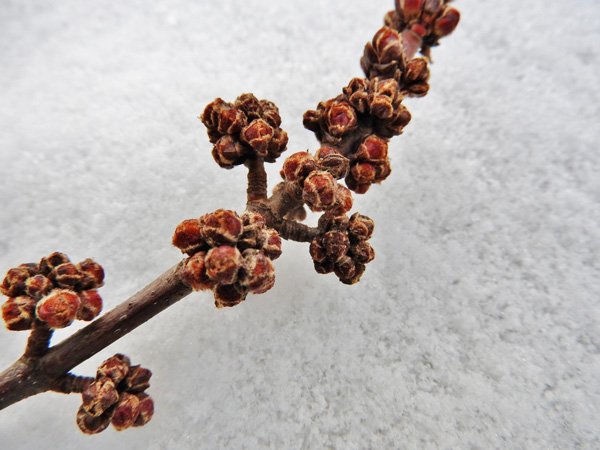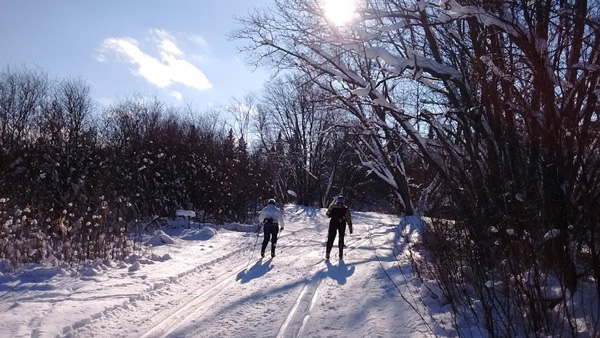News & Articles
Browse all content by date.

Perfectly firm, freshly groomed tracks cradled our skis. Bright sun warmed our faces despite an occasional breeze. A sinuous, brown and white river caressed our looping length of trail. And a half-tunnel of arching tree branches cupped us in their arms. The River Trail at ABR ski touring center in Ironwood, MI, was treating us well for this first long ski of the year.
I paused at an intersection to let my companions catch up, and found myself admiring a line of trees perched on the bank of the Montreal River. Each tree was actually a cluster of trunks, united at the base and spreading gently out toward space and sunlight like a giant, woody bouquet, with bright snow accentuating each curve. Round, red buds adorned the tip of each oppositely arranged twig, giving its crown a polka-dotted look. Gliding up, Abett asked about the tree, and I shared “silver maple” as my identification. We all admired their form.
Silver maples are classic floodplain trees in Wisconsin, and this wide, flat area along the Montreal River is perfect habitat for them and for easy ski trails. In its other reaches, the Montreal River cuts through cliffs, crashes over waterfalls, flows under the deep shade of conifers, and pours out on to a rocky Lake Superior Beach. The Ojibwe name for the river is Gaa-waasijiwaang, meaning “where there is whitewater.” It’s true that most of the water I see is white, but for a different reason. Here, (as far as I can tell under the snow) it meanders through alder thickets and grassy meadows that are soggy when not frozen.
While the dark, tannin-stained waters of the river look innocuous where they peek out through holes in the ice, they probably aren’t always so well-behaved. I cite the trees as my evidence.

The tight grouping of trunks exhibited by these silver maples is a common form among floodplain trees, and is shared by basswoods, too. Silver maples drop their helicopter seeds (the largest of any maple) in the spring. The seeds may get a wild ride to a new home if there is a flood, and the well-provisioned little explorers germinate immediately. In the moist, rich alluvial soil of the riverbank, they might spend a season or several growing straight, tall, and independent. Until another flood comes. Debris, logs, and even ice churn down the river and over its banks. The little tree doesn’t have much of a chance.
Luckily, silver maples—especially small trees less than a foot in diameter—can resprout prolifically from their stump or root crown. With an established root system already in place, I bet the second round of sprouts grows even faster than the original. By the time the next flood hits, the trees are already in defensive position, with the upstream trunks shielding the downstream trunks from damaging debris.
The roots of a silver maple aren’t just important for resprouting after damage. Any plant that lives near water needs to be adapted to having its feet wet. Even roots need oxygen in order to carry out respiration and grow. On the other side of the trail, a thicket of speckled alders takes in extra oxygen through the many lenticels (“speckles”) in their bark. They transport that oxygen to their roots. Earlier, we’d skied under a big, arching willow tree with its gnarled branches and graceful, yellowish twigs reaching all the way over the trail. Willows also use lenticels to breathe. Silver maples take a different route, and send a shallow root system near the surface where there is more oxygen.
Despite growing right next to the river, these silver maples were actually perched on slightly drier soil than you’d find a few yards inland. When a river floods, the moment its water spills over its banks, it slows down and deposits the biggest pieces of its suspended load—sand. This process builds a raised bank—a natural levee—between the river and its floodplain. So, instead of dipping their toes in the soggy muck beyond, the silver maples lined up on the natural levee can take advantage of both well-drained (and oxygenated) sandy soil, and the proximity to water. Meanwhile, their fortress of trunks protects them from the river’s fury. This is yet another example of teamwork in a forest.
Our little team of skiers continued on shortly, after exclaiming a few times about the beautiful weather, the perfect grooming, the fine company, and this gorgeous scenery. There wasn’t a cloud in the sky, but our ski even had a silver lining.
Special Note: Emily’s book, Natural Connections: Exploring Northwoods Nature through Science and Your Senses is here! Order your copy at http://cablemuseum.org/natural-connections-book/.
For over 45 years, the Cable Natural History Museum has served to connect you to the Northwoods. Come visit us in Cable, WI! Our new phenology exhibit: “Nature’s Calendar: Signs of the Seasons” is now open.
| Tweet |


